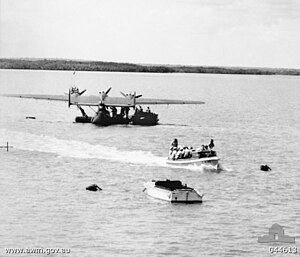
Back Luftangriff auf Broome German حمله به بروم Persian Attaque sur Broome French הפצצת ברום HE Aanval op Broome Dutch Atak na Broome Polish Нападение на Брум Russian
| Attack on Broome | |||||||
|---|---|---|---|---|---|---|---|
| Part of World War II, Pacific War | |||||||
 Personnel from a Royal Netherlands Navy Air Service Dornier Do 24 are transported by launch in Darwin Harbour, May 1941, several months before the attack on Broome | |||||||
| |||||||
| Belligerents | |||||||
|
|
| ||||||
| Commanders and leaders | |||||||
|
|
| ||||||
| Strength | |||||||
| 22 aircraft | 10 aircraft | ||||||
| Casualties and losses | |||||||
|
88 killed (official toll) 22 aircraft destroyed |
1 killed (official toll) 2 aircraft destroyed | ||||||
Location within Australia | |||||||
The town of Broome, Western Australia, was attacked by Japanese fighter planes on 3 March 1942, during World War II. At least 88 civilians and Allied military personnel were killed.
Although Broome was a small pearling port at the time, it was also a refuelling point for aircraft, on the route between the Netherlands East Indies and major Australian cities. As a result, Broome was on a line of flight for Dutch and other refugees, following the Japanese invasion of Java, and had become a significant Allied military base. During a two-week period in February–March 1942, more than a thousand refugees from the Dutch East Indies—many of them in flying boats, which often served as airliners at the time—passed through Broome.[1]
The number of refugees has previously been given as 8,000,[1] but later research by Tom Lewis contends that this figure is massively overstated. The figure was first quoted in the relevant Australian Official War History and has been reproduced in many publications since.[2] The actual number of aerial evacuees passing through Broome at this time is estimated to have been 1,350, mostly military personnel. There were approximately 250 Dutch civilian refugees, most of whom were family members of Dutch aircrews.[2][3]
